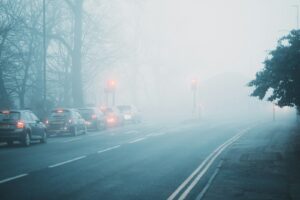Tim Dexter is the Clean Air Lead for Asthma Lung UK, overviewing their campaigns, policy and influencing projects related to air pollution.
Tim is currently focused on campaigns to influence national government policy, alongside regional campaigns in West Yorkshire, Greater Manchester and the West Midlands.
What is the state of play with lung health in the UK right now?
It’s not a pretty picture. At the moment, I believe we have the worst outcomes in terms of respiratory health of any country in Europe.
We know there are there are many different factors to this, one of which being preventative issues such as smoking and air quality but it also comes down to aspects such as treatment. We know the pressure the NHS is under, but it’s difficult for people to able to get a diagnosis for their condition and to find the right treatment pathway and that is something that definitely needs to be prioritised.
And there’s the health inequalities around that. Respiratory health is a real issue, right across the country, but particularly within communities on the poorer end of the income spectrum.
How has lung health improved in the UK compared to other diseases? Has it been slightly forgotten about?
It feels that way. Respiratory illness is the third biggest killer in the UK, behind cancer and cardiovascular disease, but it receives a fraction of the research funding. And that’s one of the things that we, trying to raise money for research.
How much is air pollution a factor in lung disease?
It’s a huge contributing factor. We run regular surveys with our beneficiaries who say that they have a lung condition and when we do this, about 50% of people say that air pollution has a detrimental impact upon their condition.
This can be wide-ranging, from starting to feel a bit wheezy, feeling a bit breathless, noticing that’s it’s a bit more difficult when they’re walking along a busy road, to feeling like they’re trapped in their homes and can’t go outside, when the air quality affects them so deeply that that they put themselves into a self-imposed lockdown. And obviously we know the wider impact that can have, on people’s physical and mental health from years of COVID.
Do you believe there is a greater awareness of the problems surrounding air pollution in general, and specifically among people who suffer from asthma and lung diseases?
I think there is some improvement in that but it’s still not anywhere where it needs to be. What we really need to see is a broader public health awareness campaign to really hammer this home. And we need to see it integrated within the direct advice and guidance that people receive from their clinicians and their GPS.
Once that connection is made, I think that’s when people will get the confidence to be able to connect it to what’s happened with their condition. And some people already do. Some people tell us that they’ve that lived in London all their life, they move out to a more rural area and all of a sudden it feels like a whole new lease of life, something they didn’t expect. The fact that they’re able to go outside, they’re able to enjoy time with their children.
But that’s not something we need to be advocating for. We don’t need everyone to move out to rural areas. We need the air quality to be better right across the country, and it shouldn’t be down to people to move house or put themselves in lockdown to be able to protect themselves from toxic air.
How much of Asthma + Lung UK’s work is directed towards air quality?
It’s one of our big missions, speaking to policy makers, trying to make sure that we see change at national, regional, local levels, because this is an issue that you can take action on at every step of the policy ladder.
It’s also about raising awareness around air quality, integrating it into our health advice, what we tell people when they come to us asking for that guidance. We’ve also started to do some more proactive programs around this, such as a programme called Clean Air Champions in schools.
For the first year it was just in London, but we’ve rolled it out nationwide, working with hundreds of schools to help them monitor the air quality immediately outside the school gates to get a sense of what it’s what it’s like. We’ll use that to help raise awareness within the school and the wider community that’s connected to the school as well.
Last year you campaigned for a ‘transport plan for a greener, fairer future’. How much does a new government give you hope that things can change?
I felt like the last couple of years there’s been a kind of a stagnation in this issue, there’s been no real willingness to move it along. We’ve seen plans that were in place, such as in Greater Manchester, not come to fruition for clean air zones.
We saw unambitious targets introduced in the Clean Air Act, and which while it’s great to have those targets they aren’t really fit for purpose. I’ve got a two year-old and he’ll be 18 by the time those targets even come into effect.
The new Government have spoken a lot more positively around clean air, which has been great to see, and there was a possibility that we might see a Clean Air Act included within the manifesto and within the first King’s Speech so we were really disappointed not to see that.
But it’s great that we’re not getting the same kind of toxic conversation around clean air. We’re not talking about it in terms of a war on motorists. So there is more positive direction of travel in terms of that.
A lot of the initial successes are very much connected to other areas that we’re seeing progress in, such as improvements within public transport and active travel. But until we start to get a clearer picture of what the wider strategy and approach is, we’re obviously going to keep making sure that we’re holding their feet to the fire on this. Very much a metaphorical fire, given the subject matter.
You have focussed on transport a lot recently, is this likely to change?
Ultimately, this is such a nebulous area. You can go into so many different aspects of different policy portfolios, whether that’s agriculture, construction, transport, wood burning… but the reason we focused on transport, particularly for the last few years, is because we know it’s such a key source and we know what the solution is .
We know what getting polluting cars off the road does. We know what improving active travel opportunities does, what improving public transport can do. So, it feels like a no-brainer to go after that, and it feels like a no brainer to implement those policy solutions as well. So that’s why we’ve really tried to focus that.
We’ll now start to look at this a bit more holistically as an issue, particularly if we feel that there’s a chance for new legislation to come in because obviously those overarching targets affect not just road transport, but absolutely everything.
Does Asthma + Lung UK have a position on LTNS ?
We don’t have a direct position on them. We get the sense that when they’re implemented correctly and with wider transport plans that they can show positive results. But we completely get that this isn’t necessarily always the case. Making sure that communities are being brought along is absolutely essential, because it’s impacting them in their day-to-day lives.
Asthma + Lung UK isn’t just about policy, is it, you deal with sufferers too?
Completely. One of the first things that we say we do is support people who have lung conditions. So, rather than just taking a top down overview of this, we have a helpline that operates 9:00 to 5:00 Monday to Friday. So people can call that up if they ever have concerns about their condition.
And we know that’s been really useful for when people feel like they might have met a bit of a dead end trying to get diagnosis or support, or if people have just found out for the first time that they have a condition and are not sure where to turn to or what to do with it.
It’s somewhere they can speak to a trained respiratory health professional to give them some advice, to offer follow up if needs be, offer opportunities for potential treatment pathways.
And then we’ve also got a broader supportive care network that can also help with some of the more practical stuff, like how people can access financial support payments from the government, to try and make sure that some of that more day-to-day stuff is also taken care of?
That’s what we see ourselves as, first and foremost, how can we offer that health advice to people with lung conditions? But we do try and embed that within our campaigns as well, as I said, this isn’t just about us trying to speak for people and on behalf of people.
You were at the transport hustings in Greater Manchester a few months ago, where we got along several people from the region who have lung conditions to come and ask questions directly to the mayor.
It’s all very well and good for us to go along to a nice meeting in City Hall or Parliament and give them a bit of paper with some stats on and we can have a good conversation about it but they’re only really going to understand the direct implications of what it is that we’re talking about when they hear from somebody who who’s like who lives there every day.
How is the treatment of asthma coming along?
It is progressing. There are other colleagues that would be able to speak better to this but there are some possible treatments in the pipeline that look positive. I think one of the big things, as ever, with this is just trying to make sure that people really understand what their medication is, what it should be and how they need to use it as well.
What is positive is that in the last few years, we’ve seen a little bit more of a broader awareness of asthma, particularly within schools. So schools now will have a policy about how they can support a child who has asthma, making sure that they have an inhaler and that they know how to use it and the staff are able to support. And that’s really important.
You recently hosted a photography exhibition called ‘This is Life and Breath’ (pictured above) can you tell us about that?
This is an answer to an issue that’s very real within the air quality campaigning world – how can we make the invisible visible? Because that’s one of the biggest challenges we get when trying to engage with people.
I’m sat here in Walthamstow, London and it doesn’t look like there’s any pollution. It certainly doesn’t look like what you’d see if you were to look up a stock image or pictures of the smog in the 1950s, but that doesn’t mean it’s not there and it doesn’t mean that it’s not an issue.
One of the things that we can do is make visible the actual impacts of it, so that’s what we’ve looked to do with this campaign, letting those people speak for themselves and describe the impact that it’s having, that they’ve experienced directly.
We worked with a photographer called Chris O’Donovan to capture these really striking images and their stories are underneath them and we’ve got headsets so people can listen to them telling their stories directly, which is also really powerful. We did this in West London as a community event but we’re looking to take it to Parliament.
















Leave a Reply